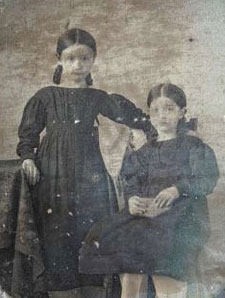- Relief printing
- Intaglio and planographic printing
- Color printing
- Bits and pieces
- Early photography in silver
- Non-silver processes
- Modern photography
- Color notes
- Color photography
- Photography in ink: relief and intaglio printing
- Photography in ink: planographic printing
- Digital processes
- Where do we go from here?
The Daguerreotype as unique object
 Daguerreotype. Photographer unknown. June 1843, Philadelphia. The earliest daguerreotypes were not toned with gold and were pale, cool in color, and fragile. This one, by an anonymous photographer, was made in Philadelphia in June 1843, an extremely early date for an American daguerreotype.
Daguerreotype. Photographer unknown. June 1843, Philadelphia. The earliest daguerreotypes were not toned with gold and were pale, cool in color, and fragile. This one, by an anonymous photographer, was made in Philadelphia in June 1843, an extremely early date for an American daguerreotype.
The first practical photographic processes—the daguerreotype and the paper-based method—were at war in early photography. Sharp, clear, and permanent, the daguerreotype was perfection itself, while the paper image was rough, tonally poor, and subject to terrible fading. But paper would win the war, simply because it was cheap, easy to use photographically, and—above all—because it could generate multiple copies by printing a negative more than once. Since the daguerreotype produced a direct, camera-made positive, no negative was available for later printing. The daguerreotype thrived until the 1860s, then died a slow death, but it has left us with extraordinary images, in many cases as perfect today as when they were made. Every daguerreotype is a unique object that once sat in the camera facing the subject of the picture.

